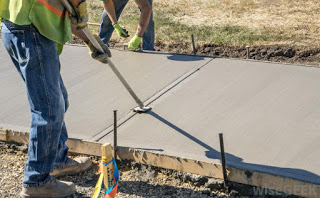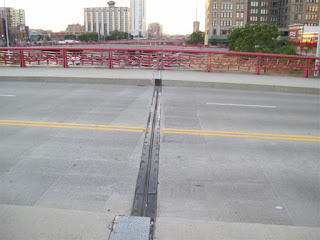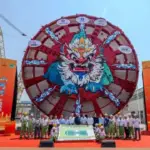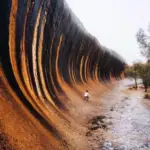A typical expansion joint is defined as :-
a joint that makes allowance for thermal expansion of the parts joined without distortion.
Parts of Expansion Joint
In a typical expansion joint, it normally contains the following components:
joint sealant,
joint filler,
dowel bar,
PVC dowel sleeve,
Like Us on Facebook!
bond breaker tape and
Subscribe Us on YouTube!
cradle bent.
Joint sealant:
it seals the joint width and prevents water and dirt from entering the joint and causing dowel bar corrosion and unexpected joint stress resulting from restrained movement.
Joint filler: it is compressible so that the joint can expand freely without constraint. Someone may doubt that even without its presence, the joint can still expand freely. In fact, its presence is necessary because it serves the purpose of space occupation such that even if dirt and rubbish are intruded in the joint, there is no space left for their accommodation.
 |
| Expansion Joint Preparation |
Dowel bar:
This is a major component of the joint. It serves to guide the direction of movement of concrete expansion. Therefore, incorrect direction of placement of dowel bar will induce stresses in the joint during thermal expansion. On the other hand, it links the two adjacent structures by transferring loads across the joints.
PVC dowel sleeve:
It serves to facilitate the movement of dowel bar. On one side of the joint, the dowel bar is encased in concrete. On the other side, however, the PVC dowel sleeve is bonded directly to concrete so that movement of dowel bar can take place. One may notice that the detailing of normal expansion joints in Highways Standard Drawing is in such a way that part of PVC dowel sleeve is also extended to the other part of the joint where the dowel bar is directly adhered to concrete. In this case, it appears that this arrangement prevents the movement of joint. If this is the case, why should designers purposely put up such arrangement? In fact, the rationale behind this is to avoid water from getting into contact with dowel bar in case the joint sealant fails. As PVC is a flexible material, it only minutely hinders the movement of joint only under this design.
Bond breaker tape:
As the majority of joint sealant is applied in liquid form during construction, the bond breaker tape helps to prevent flowing of sealant liquid inside the joint .
Cradle bar:
It helps to uphold the dowel bar in position during construction.
Keywords for this Post
expansion joint in buildings
concrete expansion joint
expansion joint concrete slab
expansion joint pdf
expansion joint filler
expansion joint types
expansion joint in piping system
expansion joint manufacturers



















